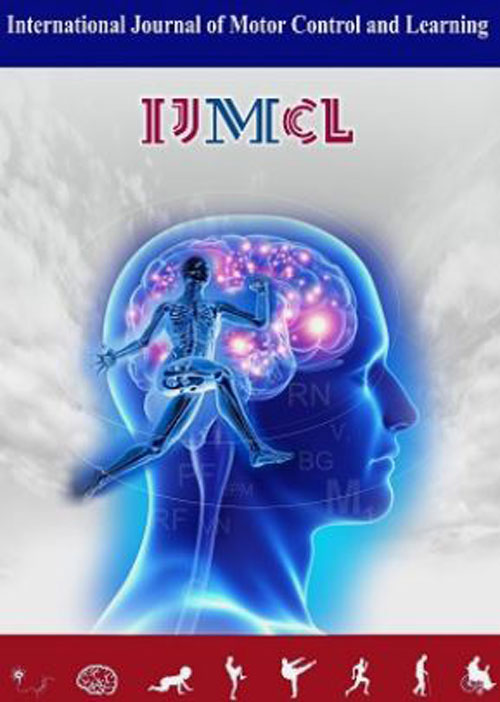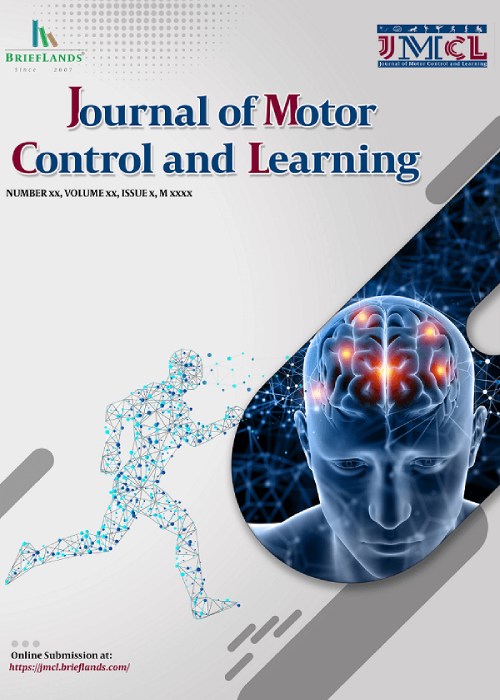فهرست مطالب

Journal of Motor Control and Learning
Volume:4 Issue: 1, Winter 2022
- تاریخ انتشار: 1401/01/29
- تعداد عناوین: 6
-
-
Pages 1-8Background
Physical Activity as a fundamental basis, generally for everyone in the community and particularly important for disabled people. The purpose of this study was to investigate the effect of Physical Activity on mental health and mindfulness in veterans and disabled people.
MethodsThe method of this research is descriptive-correlational. 100 veteran and disabled athletes and 100 veterans and non-athlete disabled participated in this research among disability institutions and rehabilitation centers in Ahvaz. The instrument used in this study was an international physical activity, mental health and mindfulness questionnaire.
ResultsThe mean age was in the athlete group (29.87 ± 3.88) and in the non-athlete group (28.25 ± 3.55). The results of independent t-test showed that there is a significant difference between the two groups, which shows the positive effect of activity on mental health and mindfulness variables in veterans and disabled athletes compared to non-athletes. It was also found that physical activity variable predicts two variables of mental health and mindfulness in veterans and the disabled. Multiple correlation coefficient was equal to MR = 0.879 and determination coefficient was equal to R2 = 0.772 which was significant at P <0.01 level.
ConclusionIn a general conclusion, participation in active activities and having sufficient mobility in veterans and disabled people can improve mental variables such as mental health and also mind awareness.
Keywords: Disabled, Mental Health, Mindfulness, Physical Activity, Veteran -
Pages 9-18Objective
To test the following hypothesis. Initial submaximal tapping at preset relatively low and high target tapping rates causes a subsequent freely chosen tapping rate to be relatively low and high, respectively, as compared with a reference freely chosen tapping rate.
MethodsParticipants performed three 3-min bouts of submaximal index finger tapping on separate days. In one bout (C, considered reference), the rate was freely chosen, throughout. In another bout (A), initial tapping was performed at a relatively low target rate and followed by freely chosen tapping. In yet another bout (B), initial tapping was performed at a relatively high target rate, followed by freely chosen tapping.
ResultsAt the end of bout A, the rate was 14.6±23.7% lower than the reference value during bout C (p = 0.023). At the end of bout B, the rate was similar to the rate during bout C (p = 0.804).
ConclusionsInitial tapping at a preset relatively low target rate caused a subsequent freely chosen rate to be lower than a reference freely chosen rate. The observation was denoted a phenomenon of motor behavioural history dependence. Initial tapping at a preset relatively high target rate did not elicit history dependence.
Keywords: Motor Behavior, Motor Control, Plasticity, Preferred Tapping Frequency, Rhythmic Movement -
Pages 19-31Objective
Running economy (RE) is a performance variable for distance runners. It can be affected by parameters such as equipment, running technique and surface. It has been shown that substantial mechanical energy will return by shoe integrated and that energy could be stored in the Muscle Tendon Units (MTU). The purpose was to investigate the influence of three difference heel positions induced by insoles on lower limb muscular activity and VO2 and RE (performance variable) changes during steady state running. It was hypothesized that with decreasing heel spring a linear increase in RE would be observed.
MethodsFifteen healthy trained male runners were tested on a treadmill submaximal pace while surface electromyography (EMG) from nine muscles of leg and thigh, the VO2 by spirometry and kinematics by 2D video camera was measured. Subjects had to run in three insoles Up Heel (UH) (14 mm heel spring), Flat insole/Heel (FH) and negative spring (DH) (Down Heel) (forefoot 5 mm higher). Data were analyzed with a repeated- measures ANOVA for significant differences between shoe insoles (p<0.05).
ResultsAnkle kinematics was systematically altered in response to the inserts (expected) by VO2 and running economy was not changed. It was shown that not all subject followed the implied changes so when looking at 10 responders a higher activity for Tibialis Anterior (TA) was shown.
ConclusionIt was concluded that heel spring potentially changes energy exchange in the triceps-surae while changes in muscle coordination may compensate for these improvements. RE is related to many factors such as running style and individually properties.
Keywords: Running Economy, Heel Positions, Insoles, Muscular Activity, Muscle Tendon Units (MTU) -
Pages 32-43Background
Generalization is a vital aspect of real-life motor learning. We asked whether in a realistic skill (bean bag throwing) generalization occurs within or beyond the range of trained movements and whether this is different for constant or variable practice.
Methodswhat was your outcomes? How you measured them? In two experiments participants threw beanbags at a target at various distances. In the first experiment (n=24), two training groups threw beanbags to a constant near or far target and were examined at an intermediate transfer test. In the second experiment (n=80), participants trained either at a single target (constant), or two targets alternatingly (variable) with targets placed at different distances and they were tested for transfer within and beyond the training range. A control group was included which only performed the transfer tasks.
ResultsFor the near transfer target, no group outperformed controls (P>.05), whereas all groups except the near constant group (P=.072) performed better than the control group at the intermediate target, and only the far constant training group performed better than controls at the far target (P<.02).
ConclusionThese results suggest that generalization is limited in this task. The generalization that was found depends mostly on the distance between the training and the transfer target, not on whether the transfer target is within the trained movement range. The superiority of the far constant group over other groups further suggests that the farther away the goal was, the greater the need for specialized training.
Keywords: Generalization, Motor Learning, Skill Acquisition, Throwing, Variability of Practice -
Pages 44-54Background
Today, a sedentary lifestyle is one of the problems of society, especially among housewives. The aim of the present study was to compare Braille Tonik exercises and physical fitness on coordination and memory of housewives.
MethodsFor this purpose, 30 housewives in the age range of 39-19 years were randomly selected and participated in a pre-posttest design of random groups (Braille Tonik exercise and physical fitness group). Both groups practiced for 6 weeks (3 sessions of 60 minutes per week). In the pre-test and post-test, the eye-hand coordination and working memory of the participants were measured by successive tennis ball throwing test and inverted number recall test, respectively.
ResultsDespite the increase in coordination between the two groups, there was no significant difference between groups (p = 0.293) and during 6 weeks of training, the average memory in the Braille Tonik group increased.
ConclusionAccording to the results, 6 weeks of Braille Tonik training and physical fitness improved eye-hand coordination; However, despite the difference in the amount of cognitive conflict and the type of movements between the two types of exercises, there was no difference in their effects on eye-hand coordination and working memory.
Keywords: Eye-hand Coordination, Physical Activity, Working Memory -
Pages 55-63Background
The mechanisms involved in expert performance have been the focus of many researchers. One of these mechanisms is visual skills. Many researchers have tried to compare these skills among expert and novice athletes to provide different solutions to enhance their expert performance. The purpose of this study was to compare the decision-making and visual search behavior of expert and novice football players.
MethodsParticipants included 14 novice male football players with an average age of 22.5 years and 14 expert male football players with an average age of 27.4 years. Both groups observed 5 attack vs. 5 attack mice. They then announced their decision, which included four pass choices by the ball-striker. At the same time, visual search behavior was assessed with the visual detector. Independent T-test was used to evaluate decision-making, saccade movements, number and time of fixations. Equality of variances was used by Levon's test.
ResultsResults showed that there was a significant difference in decision making between the two groups of expert and novice players (P <0.05). There was no significant difference in saccade movements, number and time of fixation between the two groups of expert and novice players (P <0.05).
ConclusionExpert football players may be able to extract more relevant decision-making information from the same visual field as compared to the novice player that will help to make more accurate decisions.
Keywords: Visual Search Behavior, Aye Tracking, Decision-Making, Fixation, Football Players


